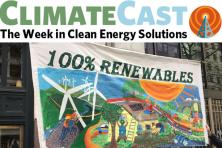A price on carbon is paying off for the Northeast
The Northeast’s cap on carbon pollution from electricity generation has yielded 14,000 jobs and $1.3 billion in economic benefit to the region in the last three years, according to a new study from the Analysis Group. RGGI (the Regional Greenhouse Gas Initiative) raised nearly a billion dollars through its carbon permit auction from 2012 to 2014, three-quarters of which was reinvested in renewable energy and efficiency measures such as weatherization. In turn, by reducing the region’s energy demands, everyone saved because utilities avoided the need to run their most expensive generators. Oh, and it’s helped the climate, too, cutting regional emissions from the power sector 40 percent since 2008.
Milestones on the road to Paris
Japan will cut its climate pollution 26 percent from 2013 levels by 2030, government officials announced last week as they finalized a plan to generate the country’s electricity in approximately equal parts from renewables, nuclear power, natural gas, and coal. This latest pledge in the run-up to December’s Paris summit comes amid speculation about how near the parties are to an accord. The pact must be strong enough, observers say, to catalyze action, but not so strong as to deter countries from ratifying it. One possibility: incentives for countries to meet their climate commitments and penalties for breaking them, similar to the framework for trade agreements.
As solar matures, interests diverge
In a sure sign that the solar industry is maturing, last week brought an op-ed duel in Hawaii between two of its major camps: local solar installers, whose Hawaii PV Coalition called for an end to net metering now that solar is cost-competitive, and the third-party leasing industry, whose business model benefits from its continuation. In California, utilities allied with rooftop solar installers to urge that lawmakers count residential solar power toward the state’s increase in its Renewable Portfolio Standard. All of these solar ownership models benefit from the growth in solar yieldcos, which allow investors to earn a steady yield from renewable energy, elegantly explained here.
Another bad week for coal
The long dethronement of King Coal continued last week, with five new power plant retirements announced in Iowa. The faltering demand for coal has punished the industry financially, with its bonds falling 17 percent in the second quarter, Alpha Natural Resources heading for bankruptcy, and mammoth asset manager BlackRock shedding its holdings in the sector. Mountaintop removal is down 62 percent since 2008 and mines are about to face stricter water pollution controls. Although industry boosters have long touted the developing world as its next growth opportunity, a close examination of the foreign coal sector shows that local opposition and lack of financing are halting many proposed power plants.
Temperature records falling, oceans rising
Trends of rising sea levels, more frequent hot days, scarcer cool nights, and warming oceans continued in 2014, according to NOAA’s annual State of the Climate report released last week. The agency’s tally of early 2015 extended that record, finding the Northern Hemisphere was 0.36 ˚F warmer than any January to June in 135 years. Even 2˚C (3.6˚F) of warming might trigger 10 feet of ocean rise within 50 years, says a discussion draft of research by James Hansen and 16 others. With polar ice receding, the five nations bordering the Arctic Ocean agreed to ban fishing in its international waters until impacts on fish populations are better understood.
Electric vehicles gain new traction
A new all-electric car-maker surfaced last week when Faraday Future announced plans to bring a high-performance EV to market. Like Tesla, the 200-person firm is named for a pioneering physicist in the field, and has poached something else from Tesla, too: a long list of key personnel. Drivers have to contend with a scarcity of charging stations in the middle of the country, but California is piloting a wide range of tools to broaden EV ownership and infrastructure; the Air Force is testing a fleet of 42 EVs that also return power to the grid; and Consumer Reports recommends the used Nissan Leaf to its readers.
Local governments not waiting to address climate
Iberdrola Renewables will use wind power to supply 35 percent of the electricity to Washington, DC’s city government, according to a 20-year agreement announced last week. New York City’s Mayor Bill de Blasio wants all city government operations to be powered with renewable energy in 10 years, and the coastal community of Elizabeth City, NC will be home to the first-ever commercial wind farm in the U.S. South. Pope Francis has taken note and invited 60 mayors from around the world—including those of Portland and Seattle—to the Vatican to sign a declaration committing to significantly reducing climate pollution and improving the health and resilience of the poor and vulnerable.





